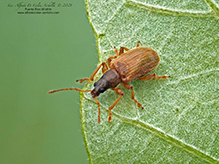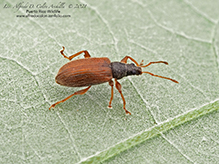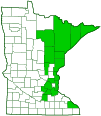European snout beetle
(Phyllobius oblongus)
Conservation • Description • Habitat • Ecology • Distribution • Taxonomy
|
|
||||||||||||||
Description |
European snout beetle is an exotic, small, early season, bi-colored, broad-nosed weevil. It is native to Europe and Siberia. In the United Kingdom it is known as brown leaf weevil, and in Germany its common name translates to bicolored narrow-bellied weevil. It was introduced and is now established in North America. It was first reported in New York in 1923. It now occurs in the United States from Maine to Maryland, west to Minnesota and Illinois, and in southern Canada from Nova Scotia west to Ontario. In Minnesota, it is common in the eastern half of the state. European snout beetle adults are active from May to June. They are found in deciduous forests, woodland borders, thickets, fens, swamps, tree nurseries, parks, and gardens. They feed on the leaves, buds, and flower petals of a wide variety of deciduous trees and shrubs, including American hophornbeam, aspen, basswood, birch, elm, hawthorn, maple, oak, raspberry, serviceberry, and willow. They feed on the margins of young leaves, and they are often first detected by seeing semicircular notches on the margins of the leaves. The larvae live in the soil and feed on the roots of trees, grasses, and other plants. European snout beetles are sometimes a pest in orchards, including apple, cherry, hazel, and pear. They are also sometimes a pest of tree nurseries. However, they seldom occur in numbers high enough to cause significant economic damage. In the U.S., the larvae are also a pest of cultivated strawberries. Adults are ⅛″ to ¼″ (3.5 to 7.0 mm) in length. The body is entirely black, long, and as the species epithet suggests, oblong. The entire surface is sparsely covered with long, pale, leaning hairs. There are no scales on the surface. The head is strongly pitted (punctate) except for a small shiny longitudinal band at the rear. It is projected forward in front into a snout-like projection (rostrum) that contains the mouthparts. The rostrum is short and broad, square or slightly wider than long. On each side of the rostrum there is a groove (scrobe) that holds the bases of the antennae when at rest. The scrobes are straight to the front margin of the eyes, and they are more or less hidden by hairs. The antennae are bent (elbowed), and they have 11 segments. The first segment (scape) is very long, curved, and gradually thickened toward the end. The second and third segments, taken together, are as long as the fourth through seventh segments. The last three segments are expanded, forming a weak club. The plate covering the first segment of the thorax (pronotum) is widest in the middle, the sides are convex, and it is narrowed to the front and to the rear. The surface is strongly and densely punctate. The wing covers (elytra) are very shallowly S-shaped (sinuate), slightly narrowed behind the shoulders, broadest beyond the middle, and broadly rounded at the rear. They are much wider than the pronotum at the base. Each elytron has several fine longitudinal grooves. The grooves are strongly pitted to the end. The space between the grooves is flat and shiny. It has a single row of very fine punctures, and a single row of hairs borne on small bumps. The elytra are variable in color. They may be yellowish or light brown to dark brown. They are often partially darkened or almost entirely dark. The legs are long, stout, pale, and entirely covered with hairs. On the male, the fourth segment (tibia) of each front leg has a strong hook on the inner side near the tip. The female has a similar but much less developed hook on each front tibia. |
Size |
Total length: ⅛″ to ¼″ (3.5 to 7.0 mm) |
Similar Species |
Habitat |
Deciduous forests, woodland borders, thickets, fens, swamps, tree nurseries, parks, and gardens |
Ecology |
Season |
One generation per year: May to June |
Behavior |
Adults are active during the day |
Life Cycle |
The female lays a small group of eggs on the ground near the base of a host plant. She will lay 100 to 200 eggs in her lifetime. When the eggs hatch, the larvae burrow into the soil and feed on the surface of roots. Mature larvae overwinter in the soil and pupate in the spring. Adults emerge in May. They are short lived and disappear by July. |
Larva Food |
Roots of trees, grasses, and other plants |
Adult Food |
Leaves, buds, and flower petals of deciduous trees |
Distribution |
||
|
Sources |
|
| 2/26/2024 | ||
Occurrence |
||
Common |
||
Taxonomy |
|
Order |
Coleoptera (Beetles) |
Suborder |
Polyphaga (Water, Rove, Scarab, Long-horned, Leaf, and Snout Beetles) |
Infraorder |
Cucujiformia |
Superfamily |
Curculionoidea (snout and bark beetles) |
Family |
Curculionidae (true weevils) |
Subfamily |
Entiminae (broad-nosed weevils) |
Tribe |
Phyllobiini |
Genus |
Phyllobius |
Subgenus |
Nemoicus |
Subordinate Taxa |
|
|
|
Synonyms |
|
Curculio floricola Curculio fuscus Curculio mali Curculio pruni Curculio querneus Curculio rufescens Phyllobius aceris Phyllobius biformis Phyllobius mandibularis Phyllobius scutarensis |
|
Common Names |
|
brown leaf weevil (UK) European snout beetle |
|
Glossary
Elytra
The hardened or leathery forewings of beetles used to protect the fragile hindwings, which are used for flying. Singular: elytron.
Pronotum
The exoskeletal plate on the upper side of the first segment of the thorax of an insect.
Punctate
Dotted with pits (punctures), translucent sunken glands, or colored spots of pigment.
Rostrum
The stiff, beak-like projection of the carapace or prolongation of the head of an insect, crustacean, or cetacean.
Scape
In plants: An erect, leafless stalk growing from the rootstock and supporting a flower or a flower cluster. In insects: The basal segment of the antenna.
Tibia
The fourth segment of an insect leg, after the femur and before the tarsus (foot). The fifth segment of a spider leg or palp. Plural: tibiae.
Visitor Photos |
||
Share your photo of this insect. |
||
This button not working for you? |
||
Alfredo Colon |
||
 |
||
MinnesotaSeasons.com Photos |
||
|
||
|
||

Visitor Videos |
||
Share your video of this insect. |
||
This button not working for you? |
||
|
Other Videos |
||
Rüsselkäfer Phyllobius oblongus |
About
Oct 16, 2012 Rüsselkäfer Phyllobius oblongus |

Created: 2/26/2024 Last Updated: © MinnesotaSeasons.com. All rights reserved. |






